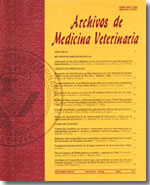Canine echinococcosis in an area of Río Cuarto Department (Córdoba, Argentina)
Main Article Content
Abstract
Hydatidosis is a parasitic zoonosis of universal distribution which is produced by a cestode, the Echinococcus granulosus. This parasite uses dogs as the epidemiological relevant definitive host, being humans and production animals the intermediate hosts.
In Argentina, the regions that present very high rates of hydatidosis transmission to man are: Patagonia, the Pampas and the Littoral. In the rest of the country, hydatidosis in humans is reported only sporadically, such as in Córdoba province whose hill area is considered an endemic one, and where there is no program to obtain an epidemiological and control studies of this zoonosis.
Two localities, El Chacay and Las Albahacas, in the south area of the Comechingones Hills, Río Cuarto Department, Córdoba Province were the working area for this study whose objectives were: a) to determine the proportion of dogs infected with Echinococcus granulosus, b) to evaluate the population’s knowledge about the hydatidic disease.
120 dogs administrated with arecoline bromhydrate (1.5 %) were sampled to obtain their fecal material. They were diagnosed by direct identification of the parasite.
The hydatidic problematic was analysed through personal interviews with the dog owners and with the (general) population.
The (dog) proportion of echinococcosis was 5% in El Chacay and 17.5% in Las Albahacas, all belonging to establishments where many hazard factors were found.
The 169 interviews showed that 70% of the cases lacked knowledge about the hydatidic disease.
Because of the public health impact of these considerations it is justified to carry on a control program of the disease.

